
The Bottom Line
Introduction, Drive Specifications, Pricing, and Availability
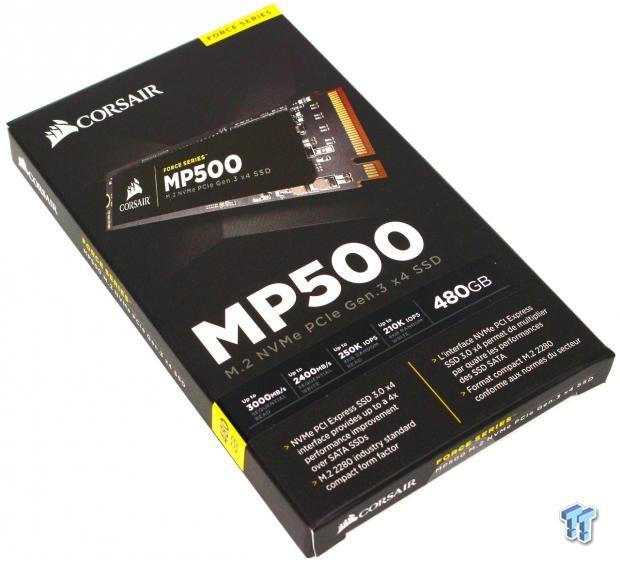
Phison E7-controlled NVMe SSDs are taking the enthusiast market by storm. We would venture to say that the E7 is the most popular third-party NVMe controller on the market. Phison controllers are among the industry's most reliable with integrated features like End-to-End Data Path Protection, SmartECC, SmartRefresh, SmartFlush, GuaranteedFlush, advanced wear-leveling and garbage collection.
Phison uses a different business model than most controller manufacturers. Most purveyors of SSD controllers sell the controller only, Phison supplies the whole SSD in the configuration of your choice. Buyers simply add their branding and sell the SSD as their own. This has proven to be a business model that is very popular because it allows vendors to deliver a proven product without needing an in-house engineering team or product assembly line.
Corsair is a company that caters to the enthusiast community. They have a well-documented history of delivering a bit more than the competition. Their newest SSD, the Force Series MP500, is no exception. There are a lot of E7-powered SSDs on the market, but Corsair's Force Series MP500 utilizes the highest-grade Toshiba 15nm flash. The MP500 is a premium product and as such costs a bit more than competing E7-powered SSDs with lesser components. Additionally, the MP500 is the first E7 drive to utilize a sleek looking black PCB which will compliment any color scheme.
The premium nature of the MP500 goes a step beyond just the major components. The MP500 is the first of its kind to employ a thermal label. The label on the MP500 has several layers to it, including a copper layer that facilitates heat dissipation. In fact, the MP500 is the first M.2 E7-powered SSD to have the label applied to the drive's controller. This should be very effective because the E7 controller has an exposed die. The label makes direct contact with the controller die, so it is very efficient at dissipating heat generated by the controller. Samsung was first to introduce a thermal label with their 960 Series SSDs, but that label does not contact the controller.
Now that we've covered the reasons why Corsair's Force Series MP500 is the most premium E7-powered SSD on the market, let's check out the performance.
Specifications
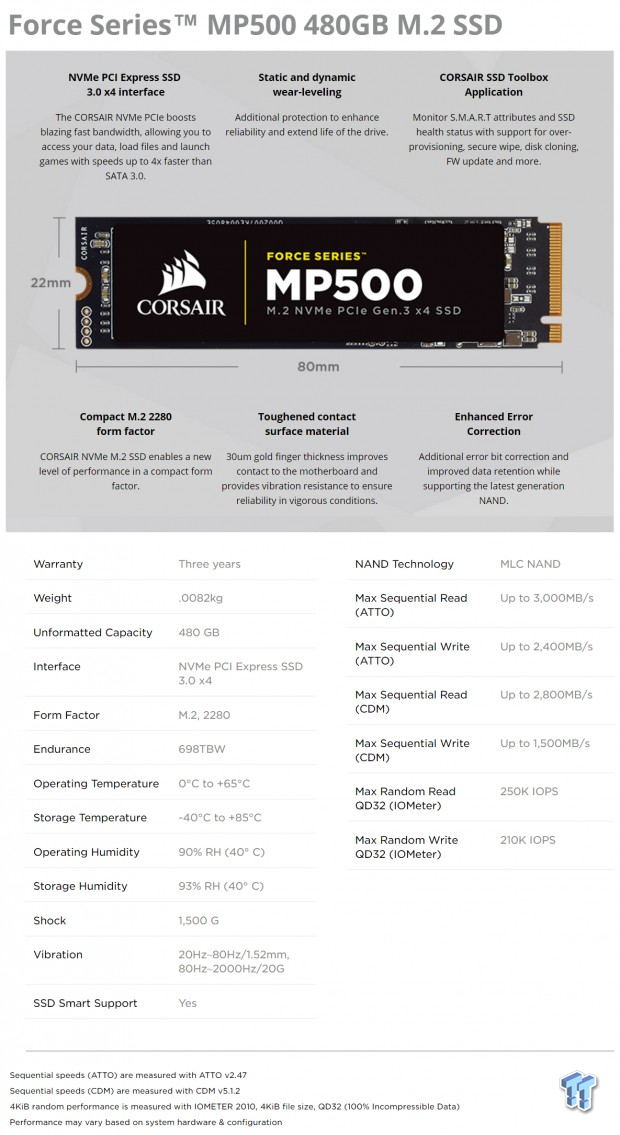
The Corsair Force Series MP500 M.2 x 2280 NVMe SSD is available in three capacities: 120GB, 240GB, and 480GB.
- Sequential Read (ATTO): up to 3,000 MB/s
- Sequential Write (ATTO): up to 2,400 MB/s
- Sequential Read (CDM): up to 2,800 MB/s
- Sequential Write (CDM): up to 1,500 MB/s
- Max 4K Random Read Speed: up to 250,000 IOPS @ QD32
- Max 4K Random Write Speed: up to 210,000 IOPS @ QD32
- Endurance: up to 698 TBW
- MTTF: 2 Million Hours
- Warranty: 3-Year Limited Warranty
- Active Power Consumption: <7W Avg.
- DevSlp: L1.2 power state supported
- Data Security: AES 256-bit for User Data Encryption
- SMART
- TRIM
- Garbage Collection
The 480GB MP500 is currently selling at Amazon and Newegg for $255. To compliment the MP500, Corsair offers a feature rich SSD Toolbox.
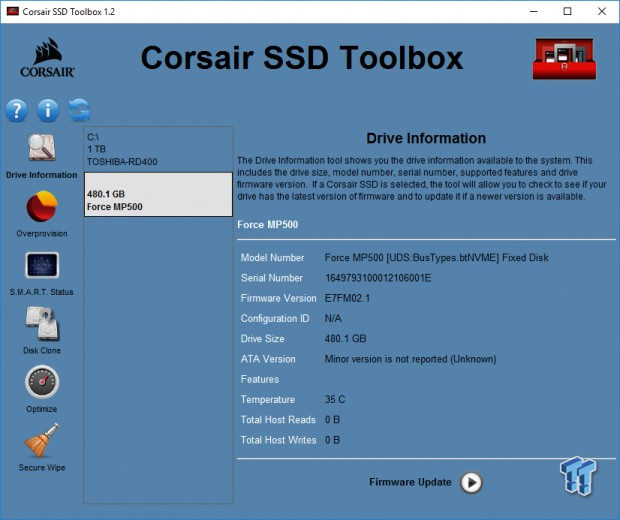
The toolbox lists drive information, allows you to easily update the firmware, overprovision, clone, optimize, and secure erase your super-fast Corsair SSD.
Drive Details
Corsair Force Series MP500 480GB M.2 NVMe PCIe SSD
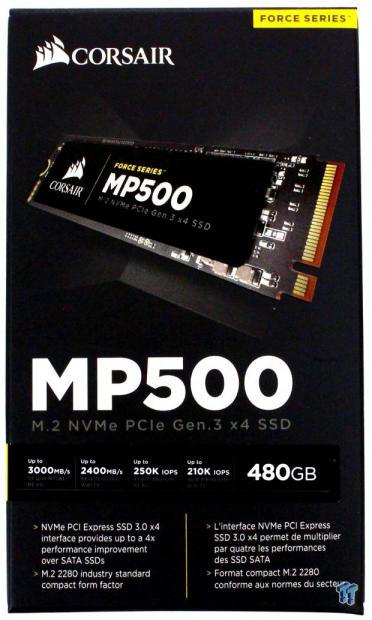
The drive ships in a small attractive black themed box. The front of the box lists some performance specifications and the enclosed drive capacity.
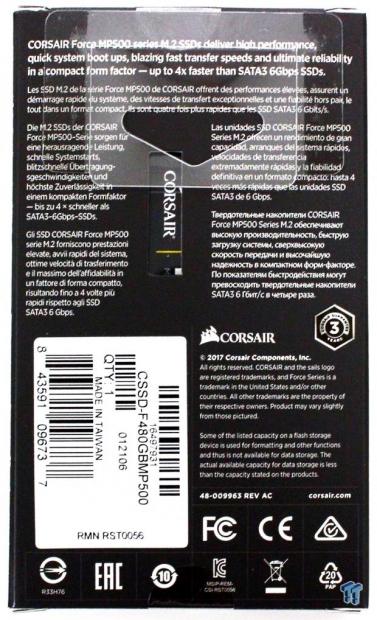
The back of the packaging lists some of the MP500's attributes and its three-year warranty.
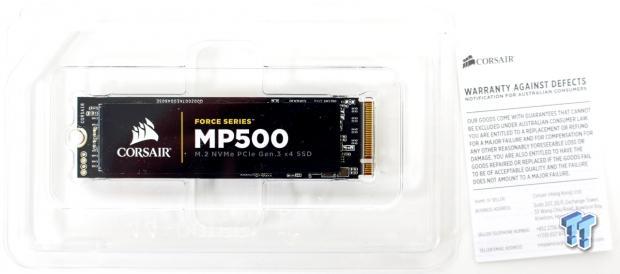
Inside the box, the drive itself is enclosed in a clear plastic clamshell container. Included is a printed warranty.

This side of the SSD is covered by a manufacturer label. This label has a thermally conductive copper layer that covers the controller, DRAM package, and two of the drive's four flash packages. We chose not to remove the label as doing so could compromise the thermal layer inside the label.

This side of the drive has a conventional label covering two of the drive's four flash packages.
Test System Setup, & Drive Properties
Jon's Consumer PCIe SSD Review Test System Specifications
- Motherboard: ASRock OC Formula Z170 - Buy from Amazon / Read our review
- CPU: Intel Core i7 6700K @ 4.7GHz - Buy from Amazon / Read our review
- Cooler: Swiftech H2O-320 Edge - Buy from Amazon / Read our review
- Memory: Corsair Vengeance LPX DDR4 16GB 3200MHz - Buy from Amazon
- Video Card: Onboard Video
- Case: IN WIN X-Frame - Buy from Amazon / Read our review
- Power Supply: Seasonic Platinum 1000 Watt Modular - Buy from Amazon / Read our review
- OS: Microsoft Windows 10 Professional 64-bit - Buy from Amazon
- Drivers: Intel RAID option ROM version 14.6.0.1029 and MS Win 10 NVMe driver
We would like to thank ASRock, Crucial, Intel, Corsair, RamCity, IN WIN, and Seasonic for making our test system possible.
Drive Properties
Corsair MP500 480GB OS Disk 75% Full
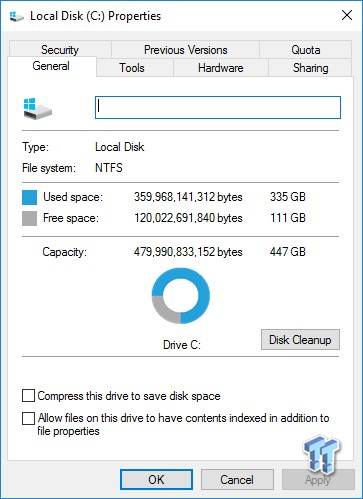
The majority of our testing is performed with our test drive as our boot volume. Our boot volume is 75% full for all OS Disk "C" drive testing to replicate a typical consumer OS volume implementation. We feel that most of you will be utilizing your SSDs for your boot volume and that presenting you with results from an OS volume is more relevant than presenting you with empty secondary volume results.
System settings: Cstates and Speed stepping are both disabled in our systems BIOS. Windows High-Performance power plan is enabled. Windows write caching is enabled, and Windows buffer flushing is disabled. We are utilizing Windows 10 Pro 64-bit OS (Build 14393) for all of our testing except for our MOP (Maxed-Out Performance) benchmarks where we switch to Windows Server 2012 R2 64-bit. Empty Windows 10 benchmark screenshots will also be shown on our MOP page.
Synthetic Benchmarks - ATTO & Anvil Storage Utilities
ATTO
Version and / or Patch Used: 3.05
ATTO is a timeless benchmark used to provide manufacturers with data used for marketing storage products. When evaluating ATTO performance, we focus on the drive's performance curve.
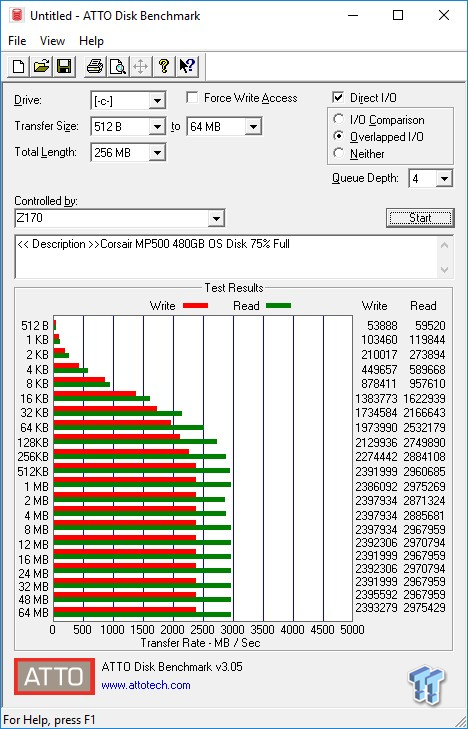
Sequential read/write transfers max out at an impressive 2,975/2,397 MB/s. Keep in mind this is our OS volume, and it is filled to 75% of its total capacity. ATTO uses compressible sequential data. Phison's E7 controller is unique among NVMe controllers in that it handles compressible and incompressible data differently.
Sequential Write

The MP500 and the BPX follow a similar performance curve, with the MP500 being slightly better. Both E7-powered drives outperform the competing drives in our test pool when the data is compressible, and transfer sizes are 64KB or larger.
Sequential Read
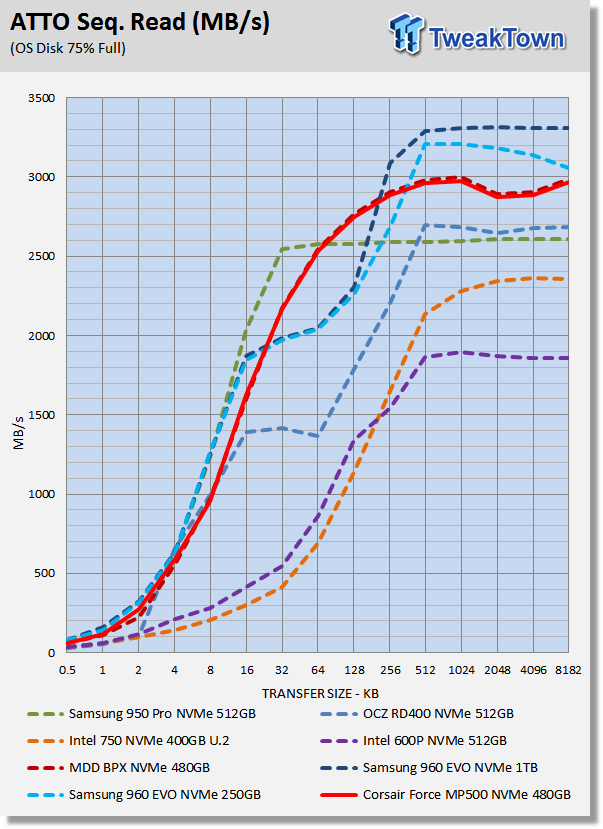
The MP500 gets the better of OCZ's RD400, and Intel's 750 and 600p. Samsung's 960 EVO delivers the best performance at transfers larger than 256KB. Overall, the 950 Pro leads the pack with the best small-file transfer rates.
Anvil Storage Utilities
Version and / or Patch Used: 1.1.0
Anvil's Storage Utilities is a storage benchmark designed to measure the storage performance of SSDs. The Standard Storage Benchmark performs a series of tests; you can run a full test or just the read or write test, or you can run a single test, i.e. 4K QD16. When evaluating performance with Anvils, we focus on the total score. When evaluating NVMe SSDs, we are looking for a minimum total score of over 10K.

Scoring

Anvil's scoring gives a good indication of a drive's overall performance. In terms of overall scoring, the MP500 gives us what we are looking for. Interestingly, the MDD BPX scores a bit higher than the MP500.
(Anvil) Read IOPS through Queue Depth Scale

With our configuration, we attained 209K random read IOPS at QD32. Keep in mind that this is our OS disk and it is 75% full which is the reason we are unable to attain the 250K IOPS listed on Corsair's spec sheet.

The MP500 and BPX display an identical performance curve up to QD32. At queue depths more than 32, the MP500 has a slight advantage that likely stems from having more premium flash array. Random read performance is one area where E7-powered SSDs are generally outperformed by competing NVMe SSDs.
(Anvil) Write IOPS through Queue Scale

With our configuration, we attained 197K random write IOPS at QD32. Keep in mind that this is our OS disk and it is 75% full.

Samsung's 960 EVO dominates across the board. The MP500 hits its stride at QD8 and higher where it delivers better performance than all but the 960 EVO. However, at lower and more common consumer queue depths, the MP500 can't keep up with the competition. Again, we see that the MP500 has an advantage over the BPX at higher queues.
Synthetic Benchmarks - CrystalDiskMark & AS SSD
CrystalDiskMark
Version and / or Patch Used: 3.0 Technical Preview
CrystalDiskMark is disk benchmark software that allows us to benchmark 4K and 4K queue depths with accuracy. Note: Crystal Disk Mark 3.0 Technical Preview was used for these tests since it offers the ability to measure native command queuing at QD4. When evaluating CDM results, we focus on 4K random performance at QD1 and QD4.


The BPX and the MP500 are both E7-powered SSDs. The BPX is cheaper, the MP500 a slightly better flash array. CDM displays the performance advantage that the MP500 has over the BPX, most notably at 4K QD4.
With this version of CDM, sequential performance is measured at QD1 which is the reason sequential rates are lower than Corsair's quoted numbers which are measured at QD32.

Again, the MP500 has the advantage over the BPX, this time it is at every measured data point.
AS SSD
Version and / or Patch Used: 1.8.5611.39791
AS SSD determines the performance of SSDs. The tool contains four synthetic as well as three practice tests. The synthetic tests are to determine the sequential and random read and write performance of the SSD. We evaluate AS SSD performance in terms of overall score.
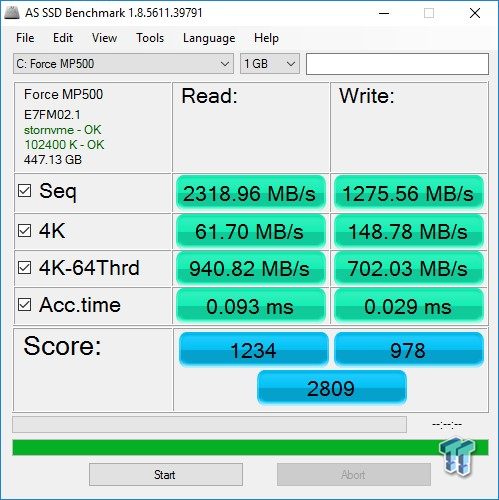
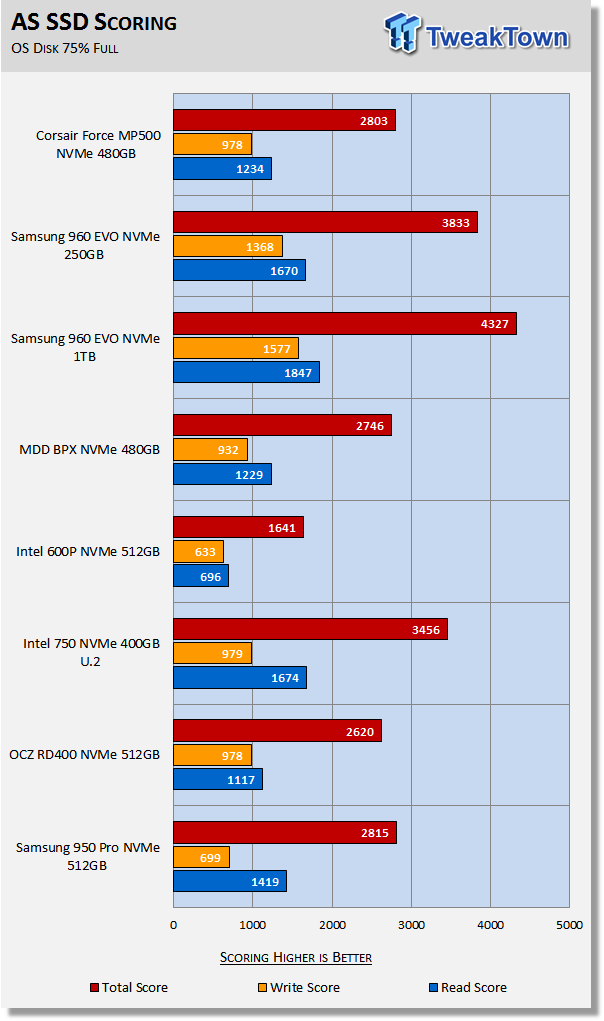
AS SSD is a demanding test, and the MP500 has no problem dispatching it with ease. This is the highest score we've seen from a retail E7-powered SSD when loaded up with data. However, Intel's 750 and the Samsung offerings deliver better performance.
Benchmarks (OS) - PCMark Vantage, PCMark 7 & PCMark 8
Moderate Workload Model
We categorize these tests as indicative of a moderate workload environment.
PCMark Vantage - Hard Disk Tests
Version and / or Patch Used: 1.2.0.0
The reason we like PCMark Vantage is because the recorded traces are played back without system stops. What we see is the raw performance of the drive. This allows us to see a marked difference between scoring that other trace-based benchmarks do not exhibit. An example of a marked difference in scoring on the same drive would be empty vs. filled vs. steady state.
We run Vantage three ways. The first run is with the OS drive 75% full to simulate a lightly used OS volume filled with data to an amount we feel is common for most users. The second run is with the OS volume written into a "Steady State" utilizing SNIA's consumer guidelines. Steady state testing simulates a drive's performance similar to that of a drive that been subjected to consumer workloads for extensive amounts of time. The third run is a Vantage HDD test with the test drive attached as an empty, lightly used secondary device.
OS Volume 75% Full - Lightly Used

OS Volume 75% Full - Steady State

Secondary Volume Empty - FOB
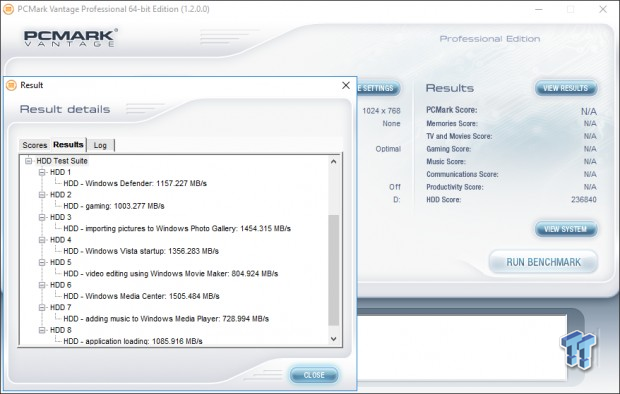
There's a big difference between an empty drive, one that's 75% full/used, and one that's in a steady state.
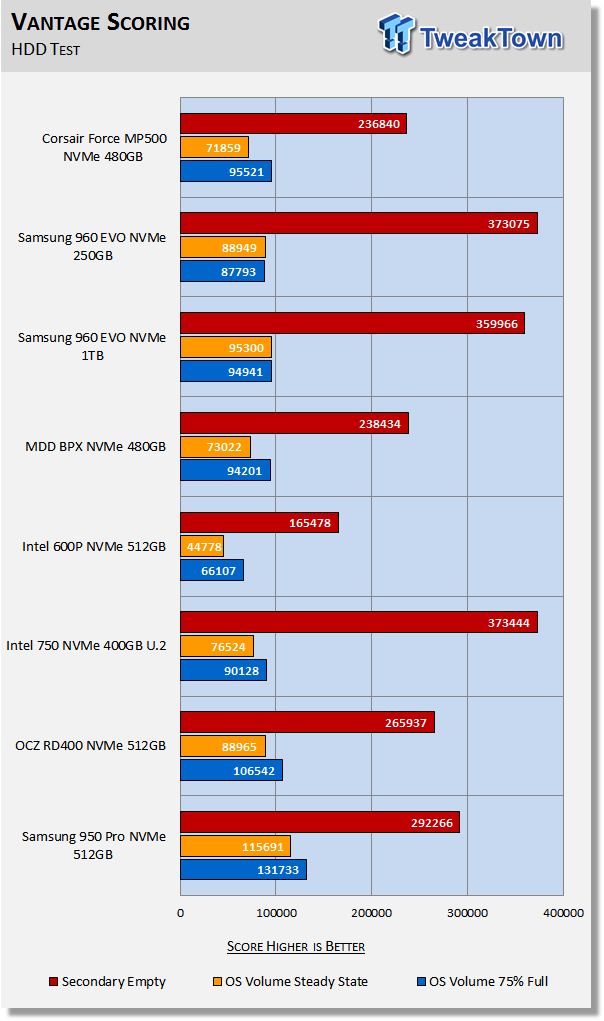
The important scores to pay attention to are "OS Volume Steady State" and "OS Volume 75% full." These two categories are most important because they are indicative of typical of consumer user states. When a drive is in a steady state, it means garbage collection is running at the same time it's reading/writing.
The MP500 and the BPX perform about the same in this testing. The rest of the test pool, except for the 600p, all deliver better performance when running in a steady-state.
PCMark 7 - System Storage
Version and / or Patch Used: 1.4.0
We will look to Raw System Storage scoring for evaluation because it's done without system stops and, therefore, allows us to see significant scoring differences between drives.
OS Volume 75% Full - Lightly Used


PCMark 7 more accurately represents real-world performance than does Vantage. This time the BPX outperforms the MP500. The MP500 outperforms the 960 EVO and both Intel offerings. It is also important to note that the MP500 does not have the benefit of a dedicated driver.
PCMark 8 - Storage Bandwidth
Version and / or Patch Used: 2.4.304
We use PCMark 8 Storage benchmark to test the performance of SSDs, HDDs, and hybrid drives with traces recorded from Adobe Creative Suite, Microsoft Office, and a selection of popular games. You can test the system drive or any other recognized storage device, including local external drives. Unlike synthetic storage tests, the PCMark 8 Storage benchmark highlights real-world performance differences between storage devices.
OS Volume 75% Full - Lightly Used


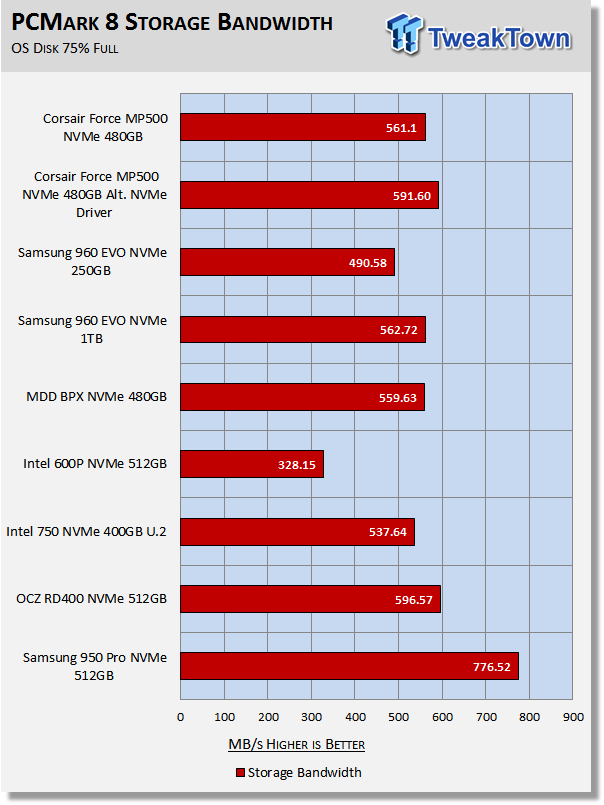
PCMark 8 is the most intensive moderate workload simulation we run. With respect to moderate consumer type workloads, this test is what we consider the best indicator of a drive's performance.
In a real-world setting, the MP500 delivers the goods. The MP500 edges out the BPX and essentially ties the 960 EVO 1TB. We would really like to see Phison offer a dedicated NVMe driver.
The Windows 10 NVMe driver is especially bad. When we run an alternative NVMe driver, E7-powered SSDs become competitive with OCZ's powerful RD400. We aren't going to elaborate on what "alternative" NVMe driver we used, other than to say you can force any NVMe driver onto any NVMe SSD through the device manager.
Benchmarks (Secondary) - IOPS, Response & Transfer Rate
Iometer - Maximum IOPS
Version and / or Patch Used: Iometer 2014
We use Iometer to measure high queue depth performance. (No Partition)
Max IOPS Read

Max IOPS Write

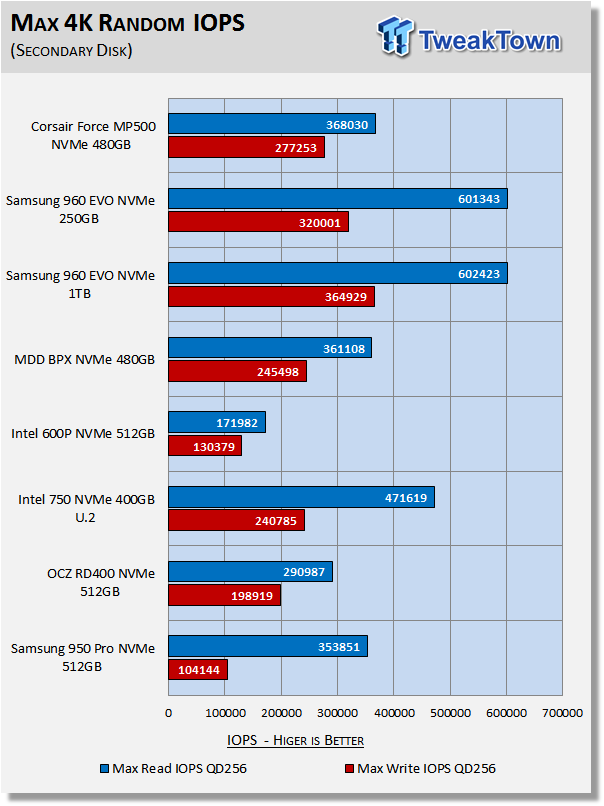
We test NVMe SSDs using eight threads at QD32 or QD256. We do this because we want to see what the drive can generate at its maximum viable queue depth.
Here we see the MP500 cranks out significantly better performance than the BPX, especially when writing data at high queue depths.
Iometer - Disk Response
Version and / or Patch Used: Iometer 2014
We use Iometer to measure disk response times. Disk response times are measured at an industry accepted standard of 4K QD1 for both write and read. Each test runs twice for 30 seconds consecutively, with a 5-second ramp-up before each test. We partition the drive/array as a secondary device for this testing.
Avg. Write Response

Avg. Read Response


Strangely enough, the BPX has better (lower) response than the MP500. Intel's 750 has by far the best write response, the 950 Pro by far the best read response.
DiskBench - Transfer Rate
Version and / or Patch Used: 2.6.2.0
We use DiskBench to time a 28.6GB block (9,882 files in 1,247 folders) composed primarily of incompressible sequential and random data as it's transferred from our Toshiba RD400 1TB NVME SSD to our test drive. We then read from a 6GB zip file that's part of our 28.6GB data block to determine the test drive's read transfer rate. Our system is restarted prior to the read test to clear any cached data, ensuring an accurate test result.
Write Transfer Rate

Read Transfer Rate

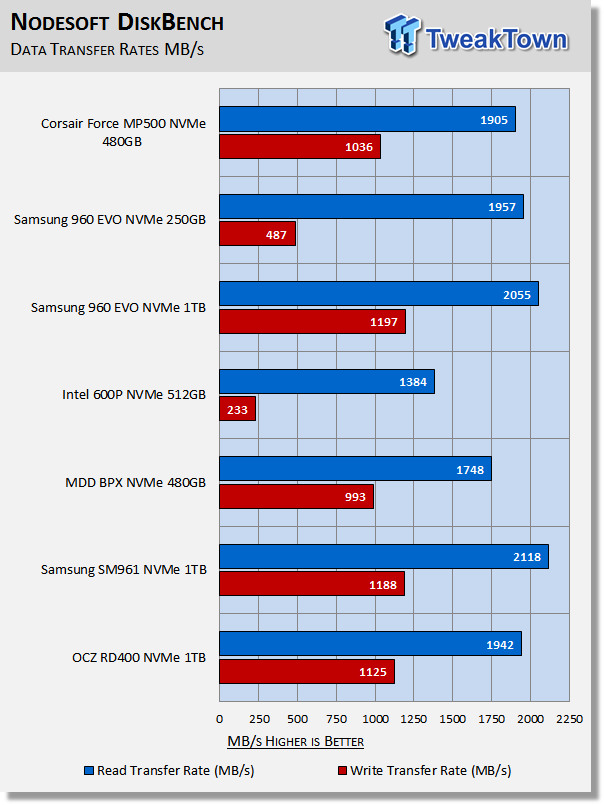
We recently upgraded our test system to Windows 10 build 14393. With that upgrade, write transfer rates almost doubled. The reason for this, as far as we know, is that CPU power switching modes have been relaxed on the latest version of Windows 10. We included the NVMe drives we've tested to date on this build of Windows 10.
If you needed a good reason to upgrade to Windows 10 build 14393, this is a good reason. The premium flash array utilized on the MP500 delivers significantly better transfer rates than the BPX.
Benchmarks (Secondary Volume) - PCMark 8 Extended
Futuremark PCMark 8 Extended
Heavy Workload Model
PCMark 8's consistency test simulates an extended duration heavy workload environment. PCMark 8 has built-in, command line executed storage testing. The PCMark 8 Consistency test measures the performance consistency and the degradation tendency of a storage system.
The Storage test workloads are repeated. Between each repetition, the storage system is bombarded with a usage that causes degraded drive performance. In the first part of the test, the cycle continues until a steady degraded level of performance has been reached. (Steady State)
In the second part, the recovery of the system is tested by allowing the system to idle and measuring the performance after 5-minute long intervals. (Internal drive maintenance: Garbage Collection (GC)) The test reports the performance level at the start, the degraded steady-state, and the recovered state, as well as the number of iterations required to reach the degraded state and the recovered state.
We feel Futuremark's Consistency Test is the best test ever devised to show the true performance of solid state storage in an extended duration heavy workload environment. This test takes on average 13 to 17 hours to complete and writes somewhere between 450GB and 14,000GB of test data depending on the drive. If you want to know what an SSDs steady state performance is going to look like during a heavy workload, this test will show you.
Here's a breakdown of Futuremark's Consistency Test:
Precondition phase:
1. Write to the drive sequentially through up to the reported capacity with random data.
2. Write the drive through a second time (to take care of overprovisioning).
Degradation phase:
1. Run writes of random size between 8*512 and 2048*512 bytes on random offsets for 10 minutes.
2. Run performance test (one pass only).
3. Repeat 1 and 2 for 8 times, and on each pass increase the duration of random writes by 5 minutes.
Steady state phase:
1. Run writes of random size between 8*512 and 2048*512 bytes on random offsets for 50 minutes.
2. Run performance test (one pass only).
3. Repeat 1 and 2 for 5 times.
Recovery phase:
1. Idle for 5 minutes.
2. Run performance test (one pass only).
3. Repeat 1 and 2 for 5 times.
Storage Bandwidth
PCMark 8's Consistency test provides a ton of data output that we use to judge a drive's performance.

We consider steady state bandwidth (the blue bar) our test that carries the most weight in ranking a drive/arrays heavy workload performance. Performance after Garbage Collection (GC) (the orange and red bars) is what we consider the second most important consideration when ranking a drive's performance. Trace-based steady state testing is where true high performing SSDs are separated from the rest of the pack.
Comparing the MP500 to the BPX, we find them delivering similar steady-state performance. However, the MP500 delivers 10% better recovery performance. We are of the opinion that the result of this test justifies the extra coin you will spend on the MP500.
The MP500 is targeted at the mainstream user, and those users will for the most part never reach a steady state, so for the mainstream user, recovery performance is more indicative of what they can expect when running a heavy workload.
Storage Bandwidth Per Phase
We chart our test subject's storage bandwidth as reported at each of the test's 18 trace iterations. This gives us a good visual perspective of how our test subjects perform as testing progresses. This chart sheds more light on how the drives perform as they progress through the testing phases.

Total Access Time (Latency)
We chart the total time the disk is accessed as reported at each of the test's 18 trace iterations. This helps shed some light on how the drive performs at each of the 18 phases of this test.

Disk Busy Time
Disk Busy Time is how long the disk is busy working. We chart the total time the disk is working as reported at each of the tests 18 trace iterations.

Data Written
We measure the total amount of random data that our test drive/array is capable of writing during the degradation phases of the consistency test. Pre-conditioning data is not included in the total. The total combined time that degradation data is written to the drive/array is 470 minutes. This can be very telling. The better a drive/array can process a continuous stream of random data; the more data will be written.
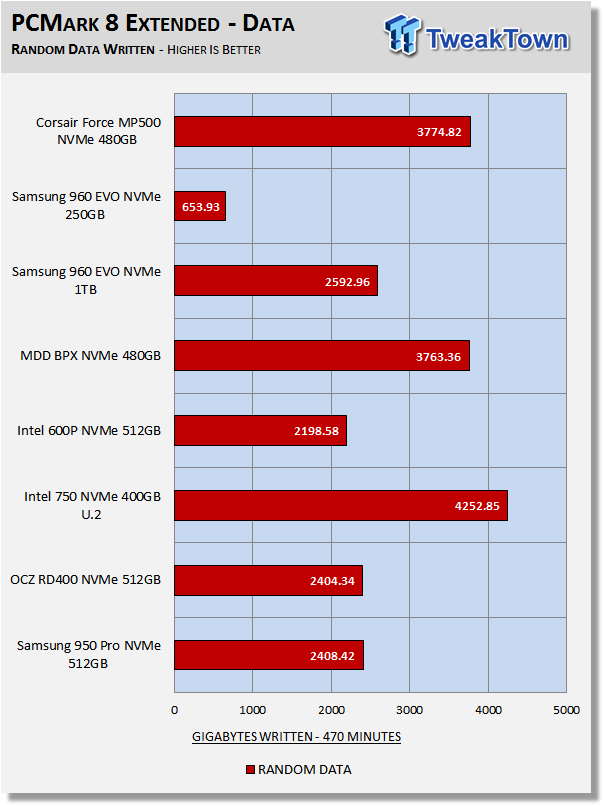
Overprovisioning and write latency are the biggest factors that determine the outcome of this portion of the test. The MP500 can write a whole lot of random data in 470 minutes. The Intel 750 wins this test because it has by far the most dedicated spare area of the drives in our test pool.
Benchmarks (Secondary Volume) - 70/30 Mixed Workload
70/30 Mixed Workload Test (Sledgehammer)
Version and / or Patch Used: Iometer 2014
Heavy Workload Model
This test hammers a drive so hard we've dubbed it "Sledgehammer." Our 70/30 Mixed Workload test is designed to simulate a heavy-duty enthusiast/workstation steady-state environment. We feel that a mix of 70% read/30% write, full random 4K transfers best represents this type of user environment. Our test allows us to see the drive enter into and reach a steady state as the test progresses.
Phase one of the test preconditions the drive for 1 hour with 128K sequential writes. Phase two of the test runs a 70% read/30% write, full random 4K transfer workload on the drive for 1 hour. We log and chart (phase two) IOPS data at 5-second intervals for 1 hour (720 data points). 60 data points = 5 minutes.

What we like about this test is that it reflects reality. Everything lines up, as it should. Consumer drives don't outperform Enterprise-Class SSDs that were designed for enterprise workloads. Consumer drives based on old technology are not outperforming modern Performance-Class SSDs, etc.
The Intel 750 wins this test easily because it has by far the most dedicated spare space or OP. The MP500 delivers the excellent performance for an E7-powered SSD, edging out the BPX by an average of 1K IOPS over the span of the test.
Maxed-Out Performance (MOP)
This testing is just to see what the drive is capable of in an FOB (Fresh Out of Box) state under optimal conditions. We are utilizing empty volumes of Windows 10 and Windows Server 2012 R2 64-bit for this testing.
Windows 10 MOP
Corsair MP500 480GB

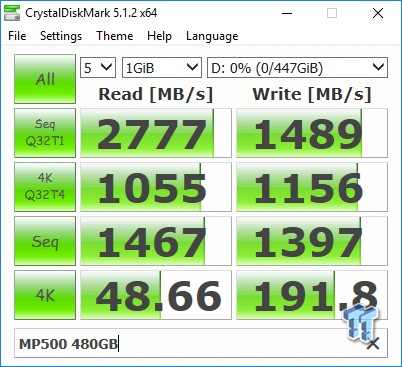

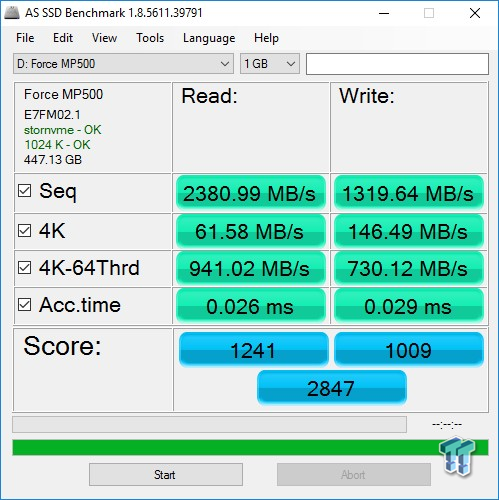


Windows Server 2012 R2 MOP
Corsair MP500 480GB


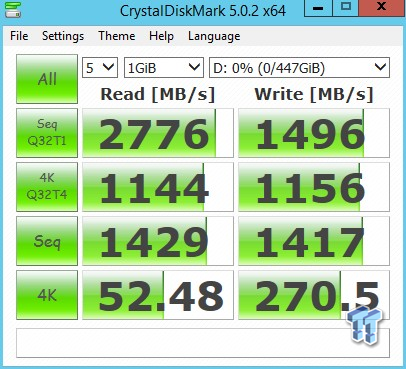




Final Thoughts
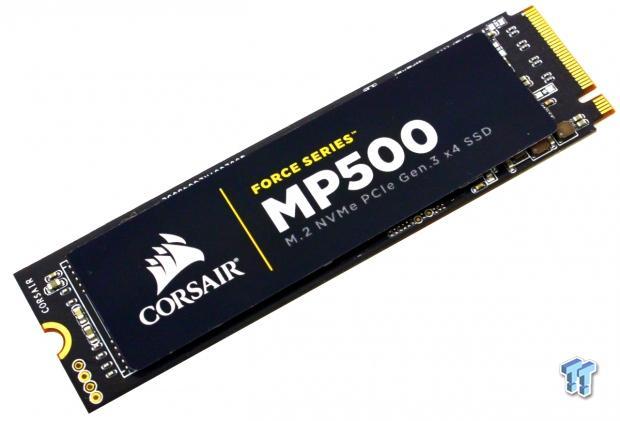
Overall, we believe that Corsair's MP500 is the most powerful Phison E7 SSD on the market, but it isn't overwhelmingly better than other E7 SSDs either. Corsair has their brand name going for it, along with better flash array. Additionally, the MP500 has thicker gold plated contacts as well as an effective thermal label, which may result in better performance in a laptop environment.
So, is the premium price worth it? For the dedicated performance enthusiast or modder, the answer is probably yes. The performance enthusiast will spend a bit more for a bit better performance; that is a given. Modders will appreciate the MP500's sleek looks and black PCB because it will complement almost any color scheme.
As with all E7-powered SSDs, Corsair's MP500 delivers in a big way when it comes to what matters most - user experience. E7-powered SSDs offer a noticeably better OS user experience than many competing NVMe SSDs. In our opinion, a user experience that is better than anything that Intel has to offer, and equivalent to what you will get from Samsung or OCZ.
Corsair's Force Series MP500 480GB NVMe M.2 SSD is TweakTown recommended.
Pros:
- Moderate Workload Performance
- Premium Components
- Most Appealing Form Factor
Cons:
- Price
- Read Performance at low QD

| Performance | 95% |
| Quality | 96% |
| Features | 95% |
| Value | 75% |
| Overall | 90% |
The Bottom Line: If you are looking for a Phison E7-powered SSD that has a bit more to offer than the rest, then Corsair's Force Series MP500 is just the ticket.
PRICING: You can find products similar to this one for sale below.
 United
States: Find other tech and computer products like this
over at Amazon.com
United
States: Find other tech and computer products like this
over at Amazon.com
 United
Kingdom: Find other tech and computer products like this
over at Amazon.co.uk
United
Kingdom: Find other tech and computer products like this
over at Amazon.co.uk
 Australia:
Find other tech and computer products like this over at Amazon.com.au
Australia:
Find other tech and computer products like this over at Amazon.com.au
 Canada:
Find other tech and computer products like this over at Amazon.ca
Canada:
Find other tech and computer products like this over at Amazon.ca
 Deutschland:
Finde andere Technik- und Computerprodukte wie dieses auf Amazon.de
Deutschland:
Finde andere Technik- und Computerprodukte wie dieses auf Amazon.de
What's in Jon's PC?
- CPU: AMD Ryzen 7800X 3D
- MOTHERBOARD: GIGABYTE AORUS Master X670E
- RAM: Kingston Fury Renegade 7200MHz 32GB
- GPU: ZOTAC AMP Extreme GeForce RTX 4090
- SSD: Crucial T700 2TB Gen5
- OS: Windows 11 Pro
- COOLER: Lian Li Galahad 360 AIO
- CASE: Lian Li Lancool III
- KEYBOARD: Corsair K65 RGB Mini
- MOUSE: SteelSeries AEROX 5 Wireless
- MONITOR: ASUS ROG Strix PG27AQN 360Hz 1440p ULMB2
Similar Content
Related Tags

